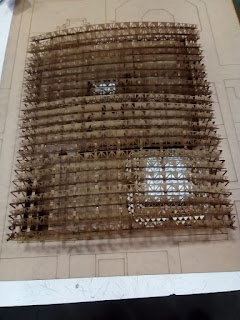The
recent annual lecture series at KRVIA titled as “Discourse on Technology” concluded
with the talk by keynote speaker Prof. Dhruv Raina. The keynote address was able to dissect through various pre-assumed concepts and framework on technology that most of
the architectural institutes conveniently have been working around with. The technology
needed much required impetus in terms of its embedded conditions, which in turn
would blur the regimented boundaries. The keynote address not only able to meet
the expectation of the theme but also allowed newer means of conceptualization.
The
Keynote brings about some of the fundamental issues related to self and constructed
understanding of technology. He began with idea of narrative that is being
re-constructed through intellectual scaffolding, about science and technology, and
they require analyzing, or needs re-examining the philosophical pre-supposition in theories. The
distinction between philosophy of science and philosophy of technology were
articulated and described as follows:
philosophy of science is Meta theory that dissects or examines
the nature of theory (realm and not domain) while philosophy of technology is
complex as it has certain embedded condition of social life and requires further investigation.
The similar
preoccupation with intellectual scaffolding that we have constructed about the notion of
high science, high technology and low technology. The fact that technical
skills required for routine problems in rural setting would mean sociological
domain of technology which cannot be categorized simply be a low tech. The Science
has produces certain understanding of human activities with technology, similar
to farmer would have knowledge about nature of soil is also an expert
knowledge.
In early
1970 there has been debate about conceptual and interdisciplinary tools for new
questions about nature of technology, and science that would allow revisit the
older question. The questions were to think about problematic issues within intellectual
scaffolding of myth. He argued further that thinking about technology is
thinking about self. It starts with concrete problems; it’s about self and society.
Concept of societies is different in various contexts. The solution in terms of technological responses is conception of self and society.
Relationship
in narrative of technology and its philosophical premises that we construct has
embedded the condition of life of technology. He enumerated the four narratives
that have been created sets of opposite myths about technology which were un-critical
myths and are polarized in nature.
i)
Two myths about technology that is myth of
autonomy “logic of technology is within technology” and other is myth of
neutrality “technology is neutral and value free”. Within which he explains the
Social determinist where the technology embodies social interest and values. (Marxism).
We need to engage with limited nature of social conditions to evolve with
appropriate technology. While technological determinism brings the realm of
autonomy and creates value free adaptation.
ii)
Divide between traditional techniques and modern
technology. The traditional techniques is pre-modern and modern technology came
about with industrial revolution with idea of new regime of production
(techniques plus production plus social organization) technology travels many
temporalities, betrays many culture and creates its own appropriateness.
iii)
The discussion of Anti - Technologist and Pro-Technologist
is within the domain of political thinking of society construct and Cultural appropriation
of technology, how it has reshaped the society and naturalized itself. Technology
of evolution is realigned with cultural trajectories. Technology is naturalized
in some case (domesticated or cultural appropriation of technology) or in some case
brings about social discontent of technology.
iv)
Technology of obsolescence vs technology of
novelty. Obsolesce is about theory of modernization and not technology per se. Technology
is outdated and novelty is necessity is clearly the mythical distinction of tradition
and modernity. The word obsolescence is embedded within modernity. The older
technology contains means and ideas and they don’t die at any point, some idea
can be re-drawn for new imagination. They are re-born in new form.
All the
narrative needs interrogation, each narrative evokes particular relation of
technology and society. We interrogate each of such relations so that it possibly
opens up new window of trajectories and technological innovation.












































































